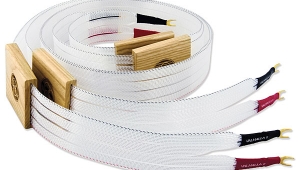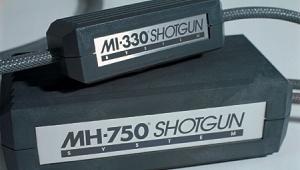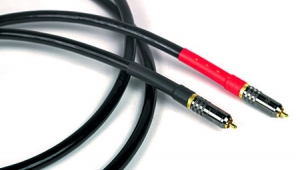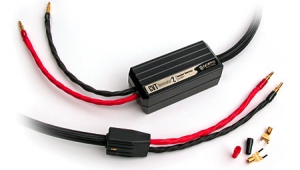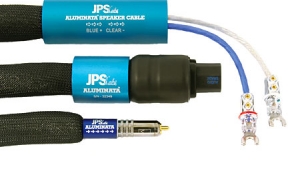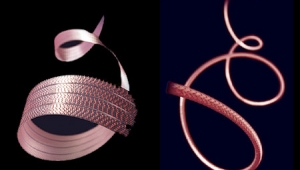| Columns Retired Columns & Blogs |
Wireworld Equinox III+ interconnect & speaker cable
We're also told that magnets can't possibly affect human athletic performance or relieve joint and muscular aches and pains. This, too, has been "scientifically" proven. Never mind that professional athletes swear by magnets, and that the disabled and the elderly have been helped as well. "Science" has proven them wrong, but medical magnet sales are exploding. Must be mass hysteria.
So here we are in the year 2000, and despite the fact that it's been scientifically "proven" that cables can't possibly make a sonic difference in your audio system, cable manufacturers continue to proliferate and thrive. Skeptics who contend that lamp cord that conforms to certain standards of inductance, capacitance, and resistance can't possibly sound different from expensive "audiophile" cable, also insist that it is up to us to prove to them that cables make a difference.
I think the shoe is on the wrong ear.
When they finally get a chance to actually listen for themselves, people easily hear differences—even people who have been inculcated with the "cables don't make a sonic difference" mantra. But, of course, they've been "fooled," haven't they. The human mind is such a suggestible, inaccurate device, why do we bother to listen at all? We should just measure music and go home.
So what happened when I removed the extravagantly expensive Yamamura Millennium 6000 interconnects and loudspeaker cables from my system (as configured for last month's review of the Audio Research Reference 2 preamplifier) and replaced them with the very reasonably priced Wireworld Equinox III+? (The interconnect costs $160 for a 1m pair, the speaker cablecosts $700 for a 2.5m pair.)
Well, I heard clear differences in a few key areas. But my friend's 17-year-old son Nick, who is a musician and my summer intern, said, "I hear absolutely no difference." Was he correct? Was I fooled because I wanted to hear a difference?
I was quite certain that Nick hadn't known what to listen for. So I switched the cables back and, without telling him the differences I'd heard, told Nick to concentrate on the bass. With the Yamamura back in the system, I played the title track of Ella Fitzgerald's Clap Hands, Here Comes Charlie!, Janis Ian's "All Roads to the River" from Breaking Silence, "Yacht Dance" from XTC's English Settlement, and "No Blues" from Smokin' at the Half Note, with Wes Montgomery and the Wynton Kelly Trio (an absolutely spectacular-sounding Speakers Corner reissue).
Then I began again with the Equinox III+. Less than a minute into "All Roads to the River," Nick exclaimed, "The bass string being struck is not nearly as clear now. It's not nearly as full-sounding, either. I hear less bass."
He was correct. Compared to the Yamamura, which costs about seven times more, the Equinox III+'s biggest problem was that bass articulation, while not bad, suffered noticeably by comparison, and the Yamamura's midbass and midrange were more fully fleshed out. Also, the Yamamura's highs were somewhat more natural, delicate, and three-dimensional. The ultra-expensive cable's net effect was a more coherent sonic picture, harmonically and rhythmically. The sound was more "acoustical," less "electronic."
But was it seven times better? Was it worth spending $1050 for a 1m pair of interconnects when you could spend only $160? (The Equinox III+ is available in longer lengths at an additional $50/0.5m. A 1m pair of Yamamura 6000 speaker cables costs $910. A 2.5m pair of Equinox III+s costs $700.)
No, the sound wasn't seven times better, but when you're spending big bucks on the rest of your gear, you don't want to skimp on cables. And since no cable is absolutely neutral in all circumstances, it's clear that finding the correct connectors for your system is key to your sonic satisfaction.
Given expensive associated equipment, if you were shopping in the Wireworld line, you'd probably want their top-of-the-line Gold Eclipse III, which I also compared to the Equinox III+ in my old listening room. It was relaxed and neutral yet vivid-sounding, with fully developed bass extension and weight, very open and well-articulated highs, and outstanding resolution of low-level details. More important, it gave nothing away at the edges, sounding coherent from top to bottom. Or perhaps I should say that it allowed my system to sound that way.
Wireworld's David Salz is obsessed with creating a truly neutral-sounding cable. Salz is obsessed, period. When I spent time with him in Germany, he offered improvements to the coffee maker, the wall, the carpets, my camera, my luggage—whatever he laid eyes on. I didn't have to ask him how he got into cable design. He lives in that zone.
Salz has designed and built a double-blind cable comparator/bypass device that inserts short jumpers between components placed back to back and inches apart [see Stereophile, August 1996—Ed.]). Two additional sets of jacks allow you to compare the direct signal with it run through two long double lengths of interconnects. I had one of these boxes, but had never had components in-house that fit the short jumpers. A newer version of the comparator eliminates the problem but requires monoblocks or a pair of identical stereo amps. Using his cable comparator, Salz believes he's come up with not just Wireworld's, but the world's most neutral-sounding cable ever: the Eclipse Gold III.
As you move down the WireWorld price line, compromises in the materials and construction cause sonic compromises as well, but the Equinox III+'s deficiencies were of a mild, subtractive nature. Top to bottom, the Equinox III+ sounded a "little less" than the very expensive Yamamura, with the most obvious loss being in the bass. But the midrange was impressively free of veiling or lumpiness, and the top end was unencumbered of grain and edge. If your system sounds a bit lumpy or clogged in the mid to low bass, the Equinox III+ might well solve the problem. In fact, to some ears and in some systems, the Yamamura might sound a bit warm, and the far less expensive Equinox III+ more open.
Although it's four rungs down the Wireworld ladder from the Eclipse Gold III, the Equinox III+'s build quality is high. The interconnect version uses gold-over-brass RCA plugs instead of the Gold Eclipse's solid silver, but the basic plug construction is the same, including the Teflon insulation. The plug's barrel may be too wide in diameter for closely spaced RCA jacks—especially those used on some vintage gear—and it requires strong pressure to press in, due its O-ring spring fit, so be careful with flimsy jacks or chassis construction.
Despite its reasonable price, the Equinox III+ interconnect uses the same microporous Teflon dielectric and polypropylene core as Wireworld's more expensive versions, and features 85 polymer-coated, "grain-optimized" copper strands in the same construction as the Gold Eclipse III, which uses 162 strands of solid silver wire. The speaker cable features 240 coated-copper strands.
The Equinox III+ is available as a single-ended or balanced interconnect, and as regular or biwired speaker cable. Overall, given its moderate price, I thought it did a good job of getting out of the way, especially on top. Its one weak spot—its less than stellar bass performance—could be innocuous in some systems, and actually beneficial in others.
- Log in or register to post comments




